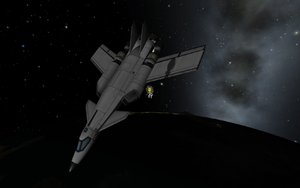Single-stage-to-orbit

A single-stage-to-orbit craft (also known as a SSTO) is any craft that can reach orbit without having to rely on multiple stages or jettisoning components. A typical SSTO takes off from a runway or launchpad and reaches orbit with only the fuel stored within the tanks of the craft. SSTOs are not exclusively required to break orbit and re-enter the atmosphere for a landing as they may be refueled in orbit. Designing a Single Stage to Orbit craft generally requires a firm grasp of spacecraft as well as aircraft design in order to create a craft that can operate both within and outside of an atmosphere without changing aerodynamic profile and size.
Contents
[hide]History
- It wasn't until C7 released his spaceplane pack in version 0.12 that spaceplanes were truly introduced into Kerbal Space Program.
- Space planes were officially included in Kerbal Space Program following version 0.15 with the addition of the Space Plane Hangar.
Approaches to constructing a SSTO
SSTOs can be constructed using various engines like their siblings the multi-stage rockets, however many issues must be considered when it comes to constructing a spaceplane. They can be constructed with several types of engines and several types of designs.
There are 2 common types of SSTOs:
- Horizontal takeoff and landing (spaceplanes, more common):
- Advantages of this design:
- It is able to reach stable orbit with less thrust (even TWR <1), which can mean serious weight savings.
- It is much easier to control the SSTO's descent during atmospheric entry.
- It is easier to achieve precise landings and to search for landing sites.
- Can be very fuel-efficient when exploring planets with atmospheres containing oxygen.
- Disadvantages of this design:
- The terrain at the landing site is extremely important (generally limited to flat areas).
- Difficult to land on bodies without atmospheres (although not impossible).
- Vertical takeoff and landing (essentially a single-stage rocket). This type of SSTO is just a large fuel tank (or tanks) and an engine capable of lifting them.
- Advantages of this design:
- Usable on celestial bodies without atmospheres.
- The terrain at the landing site doesn't matter as much.
When it comes to choosing engines for SSTOs there are two primary things that need to be addressed, thrust to weight ratio and efficiency.
- Solid fuel rocket-powered Not ideal for SSTOs as they cannot be refuelled or use fuel from other sections of the craft and the thrust can not be increased, decreased or vectored. These may be useful for emergency escape systems, however.
- Air breathing engines are extremely popular atmospheric engines for SSTOs due to their extreme fuel efficiency where oxygen is present. However, they are totally useless in space, where rocket engines must be used.
- Liquid fuel rockets are ideal for SSTOs due to the ability to vary thrust and to vector that thrust. Many SSTOs use aerospike engines due to their excellent power to weight ratio and efficiency, especially in dense atmosphere.
- The R.A.P.I.E.R. engines appear ideal for the SSTO designs, as they remove the need for separate atmospheric and space engines. However, R.A.P.I.E.R. engines are slightly less fuel-efficient than dedicated engines and so it is possible to achieve greater range by utilising some combination of both jet and liquid-fuel engines.
- Ion engines are extremely fuel-efficient in space, but produce very little thrust (and almost no thrust in an atmosphere) and require phenomenal amounts of electricity to function. Huge numbers of solar panels are required which will add a lot of weight, so they are generally not used; however, some have made ion-powered probes and even single-seater SSTOs.
- The LV-N "Nerv" Atomic Rocket Motor is an ideal engine to use in conjunction with R.A.P.I.E.R. engines as it provides high efficiency to complete Orbit and allows even simple SSTOs to have more than 3000 m/s of delta-v left. As it only uses Liquid Fuel SSTOs need to carry significantly less Oxidizer.
Whether rocket-powered or air-breathing, a reusable vehicle must be rugged enough to survive multiple round trips into space without adding excessive weight or maintenance. In addition a reusable vehicle must be able to reenter without damage, and land safely.
An example stock craft which is a working single-stage-to-orbit spaceplane is the Aeris 4A.
Issues to consider while constructing
Spaceplane construction is far more involved and complex than rocket design. Whereas when designing rockets one only needs to pay attention to structural stability, center of gravity, and center of thrust, when designing spaceplanes one also needs to be concerned about the center of lift, angle of attack, as well as aerodynamic drag due to the non-symmetrical vertical nature of aircraft.
Features and benefits
- Can be more efficient at reaching orbit than multi-stage rockets when using air breathing engines in atmosphere with oxygen. That is because they use intake air instead of oxidizer while in the atmosphere, reducing weight and fuel requirements.
- Does not jettison expensive engines and structure.
- Prevents having to recover and refurbish jettisoned components.
- Can operate like an aircraft within the atmosphere in case of spaceplane design.
Disadvantages
- Spaceplane type SSTOs cannot be as heavy as a vertical rocket due to structural limitations.
- Spaceplane SSTOs require a solid grasp on aerodynamics.
- Very fuel inefficient for carrying heavy loads into orbit, especially with fully rocket engine propulsion.
- Typically do not carry enough fuel for inter-planetary travel, and their dry/wet weight ratio is worse.
- Harder to design than multi-stage rockets.
- Typically more expensive than disposable options. While this is mitigated by the fact that they are normally reusable, a crash that can't be reverted represents a larger financial loss than is normal.
See also
- Single-stage-to-orbit on Wikipedia
